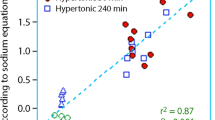Abstract
The sensitivity of whole-body electrical impedance measurements to changes in the volume of total body water in 12 children undergoing haemodialysis has been assessed. The impedance (I) of each child was measured at 20-min intervals during dialysis using the standard four-electrode technique to apply a constant current (800 μA, 50 kHz) between the wrist and ankle on the nonfistula side of the patient. The ultrafiltration volume (U) was also recorded. A simple electrical model suggests that U = aHt2 ((1I0)-(1/I)), where lo is the whole body impedance at the start of dialysis, a is a constant and Ht is patient height. No significant changes in I were measured on 4 patients undergoing dialysis without ultrafiltration, whereas in 8 patients undergoing ultrafiltration and dialysis I increased. Linear regression analysis and the above equation gave a mean value for a = 0.566 1 Ohm/cm2 (coefficient of variation = 3%), (meanr = 0.97), values comparable to those values obtained from isotope dilution studies. Predicted fluid loss in 8 patients following a single dialysis session gave a mean overestimate of 4.3% (limits of agreement 27.3% and −19.7%), although in 6 of the patients agreement was to within 6%. Changes in impedance reflect changes in total body water in children undergoing haemodialysis and are relatively insensitive to factors such as the possible differences in electrolyte levels between these patients.
Similar content being viewed by others
References
Hoffer EC, Meador CK, Simpson DC (1969) Correlation of whole body impedance with total body water volume. J Appl Physiol 27: 531–534
Kushner RF, Schoeller DA (1986) Estimation of total body water by bioelectrical impedance analysis. Am J Clin Nutr 44: 417–424
Lukaski HC, Bolonchuck WW, Hall CB, Siders WA (1986) Validation of tetrapolar bioelectrical impedance method to assess human body composition. J Appl Physiol 60: 1327–1332
Davies PSW, Preece MA, Hicks CJ, Halliday D (1988) The prediction of total body water using bioelectrical impedance in children and adolescents. Ann Hum Biol 15: 237–240
Azcue M, Freid M, Pencharz PB (1993) Use of bioelectrical impedance analysis to measure total body water in patients with cystic fibrosis. J Pediatr Gastroenterol Nutr 16: 440–445
Gregory JW Greene SA, Scrimgeour CM, Rennie MJ (1991) Body water measurement in growth disorders: a comparison of bioelectrical impedance and skinfold thickness techniques with isotope dilution. Arch Dis Child 66: 220–222
Kouw PM, Olthof CG, TerWee PM, Oe LP, Donker AJH, Schneider H, de Vries PMJM (1992) Assessment of post-dialysis dry weight: an application of the conductivity measurement method. Kidney Int 41: 440–444
Kurtin PS, Shapiro AC, Tomita H, Raizman D (1990) Volume status and body composition of chronic dialysis patients: utility of bioelectrical impedance plethysmography. Am J Nephrol 10: 363–367
Olthof CG, de Vries PMJM, Kouw PM, Oe PL, Schneider H, deLange JJ, Donker AJM (1993) Non-invasive conductivity method for detection of dynamic body fluid changes: in vitro and in vivo validation. Nephrol Dial Transplant 8: 41–46
Jebb SA, Elia M (1991) Assessment of changes in total body water in patients undergoing renal dialysis using bioelectrical impedance analysis. Clin Nutr 16: 81–84
Bland JM (1987) An introduction to medical statistics. Oxford University Press, Oxford, pp 188–215
Bland JM, Altman DG (1986) Statistical methods for assessing agreement between two methods of clinical measurement. Lancet 1: 307–310
McAdams ET, Jossinet J (1991) The importance of electrode skin impedance in high resolution electrocardiography. Automedica 13: 187–208
Smye SW, Norwood HM, Buur T, Bradbury M, Brocklebank JT (1994) Comparison of extracellular fluid volume measurement in children by99Tcm-DTPA clearance and multifrequency impedance techniques. Physiol Meas 15: 251–260
Smye SW, Sutcliffe J, Pitt E (1993) A comparison of four commercial systems to measure whole body electrical impedance. Physiol Meas 14: 473–478
Kong CH, Thompson CM, Lewis CA, Hill PD, Thompson FD (1993) Determination of total body water in uraemic patients by bioelectrical impedance. Nephrol Dial Transplant 8: 716–719
Author information
Authors and Affiliations
Rights and permissions
About this article
Cite this article
Bradbury, M.G., Smye, S.W. & Brocklebank, J.T. Assessment of the sensitivity of bioimpedance to volume changes in body water. Pediatr Nephrol 9, 337–340 (1995). https://doi.org/10.1007/BF02254204
Received:
Revised:
Accepted:
Issue Date:
DOI: https://doi.org/10.1007/BF02254204




